Basic
In simple terms, if you want to add a legend to your map, set legend = TRUE. This will add a legend for either fill_colour or stroke_colour values (depending on which one the layer supports)
mapdeck() %>% add_scatterplot( data = capitals , lat = "lat", lon = "lon" , radius = 500000 , fill_colour = "country" , legend = TRUE )

legend
In more-complex-but-still-simple terms, if the layer supports multiple fill and/or strokes, and you only want to show one of them in the legend, you can use a list to specify which coloured variables are included, such as
url <- 'https://raw.githubusercontent.com/plotly/datasets/master/2011_february_aa_flight_paths.csv' flights <- read.csv(url) flights$id <- seq_len(nrow(flights)) flights$stroke <- sample(1:3, size = nrow(flights), replace = T) flights$info <- paste0("<b>",flights$airport1, " - ", flights$airport2, "</b>") flights$airline <- as.character( flights$airline ) flights$airport1 <- as.character( flights$airport1 ) flights$airport2 <- as.character( flights$airport2 ) mapdeck() %>% add_arc( data = flights , layer_id = "arc_layer" , origin = c("start_lon", "start_lat") , destination = c("end_lon", "end_lat") , stroke_from = "airport1" , stroke_to = "airport2" , stroke_width = "stroke" , tooltip = "info" , auto_highlight = TRUE , legend = list( stroke_from = TRUE, stroke_to = FALSE ) )
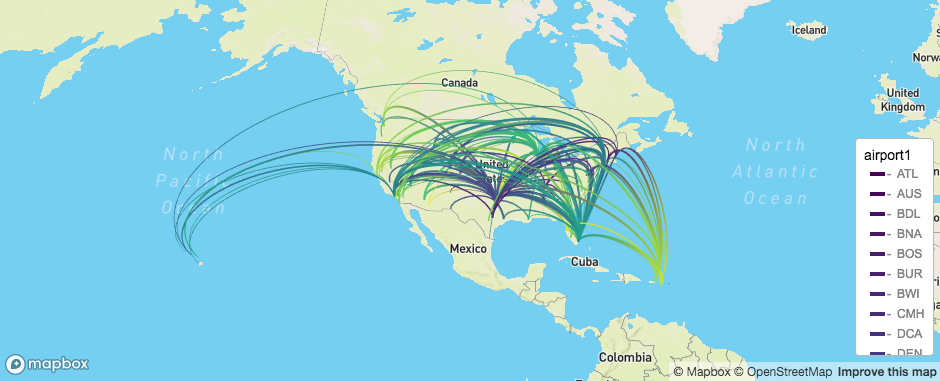
legend
Formatting
There are two ways to format the legends
-
legend_optionsfor controlling the appearance of the legend -
legend_formatfor formatting the values in the legend
Legend Options
In the legend_options argument you use a list to control the title, css and digits (number of decimal places) of the legend
mapdeck() %>% add_arc( data = flights , layer_id = "arc_layer" , origin = c("start_lon", "start_lat") , destination = c("end_lon", "end_lat") , stroke_from = "airport1" , stroke_to = "end_lon" , stroke_width = "stroke" , tooltip = "info" , auto_highlight = TRUE , legend = TRUE , legend_options = list( stroke_from = list( title = "Origin airport"), stroke_to = list(title = "Destination (longitude)", digits = 3) , css = "max-height: 100px;" ## css applied to both stroke_from and stroke_to ) )
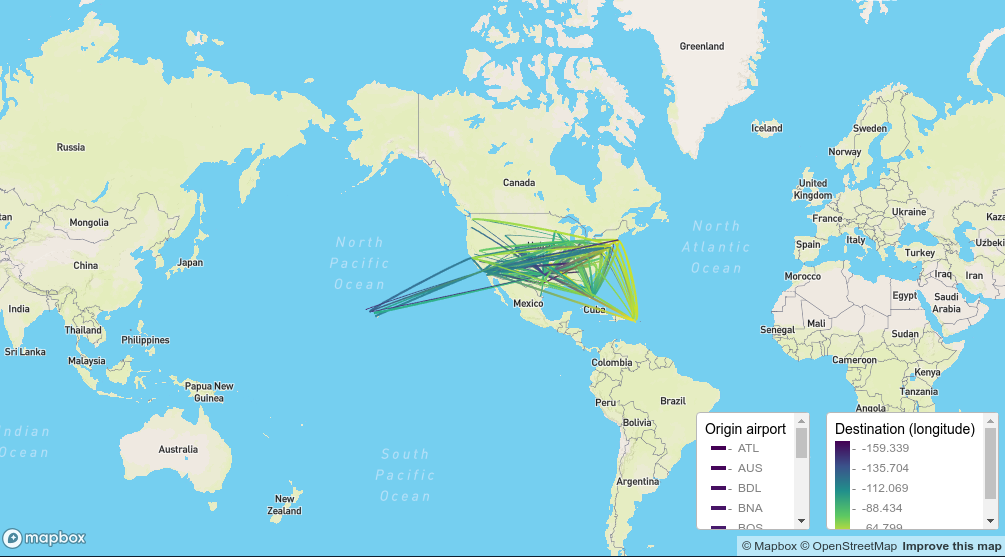
legend options
Legend Format
This argument lets you control the appearance of the values in the legend. Simply pass in a function to apply to the values.
mapdeck() %>% add_polygon( data = melbourne , polyline = "polyline" , fill_colour = "AREASQKM" , legend = TRUE , legend_format = list( fill_colour = as.integer ) )

legend format
Formatting Dates
POSIX objects are a bit tricker. At the heart of mapdeck, all code is written in C++, and any time-zone attributes are lost from the R POSIXct object, and the underlying numeric data is converted to UTC.
df <- capitals df$date <- seq( as.POSIXct("2018-01-01 00:00:00", tz = "Australia/Melbourne"), as.POSIXct("2019-01-01 00:00:00", tz = "Australia/Melbourne"), length.out = nrow(df) ) mapdeck() %>% add_scatterplot( data = df , lon = "lon", lat = "lat" , fill_colour = "date" , radius = 500000 , legend = TRUE )
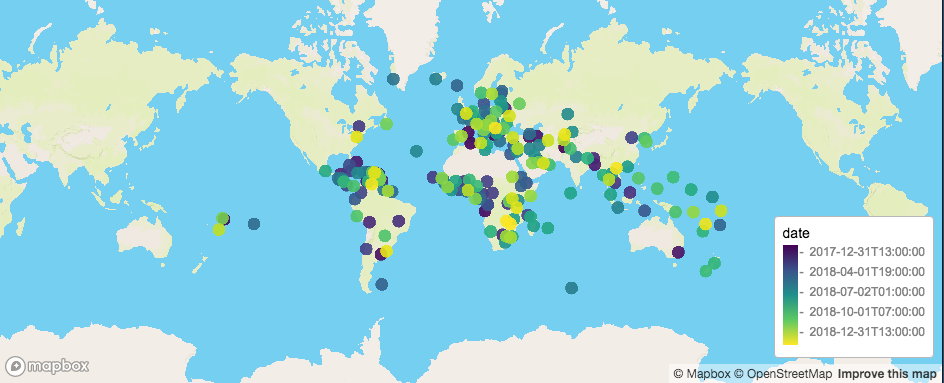
legend dates
Notice the dates have been converted to UTC, and includes the T time-zone identifier.
Therefore, if you want to convert the legend back to Australia/Melbourne, you need to use a function for this.
format_dates <- function( x ) { x <- as.POSIXct(x, tz = "UTC", format = "%Y-%m-%dT%H:%M:%S") attr( x, "tzone" ) <- "Australia/Melbourne" x <- as.character( x ) x } mapdeck() %>% add_scatterplot( data = df , lon = "lon", lat = "lat" , fill_colour = "date" , radius = 500000 , legend = TRUE , legend_format = list( fill_colour = format_dates ) )
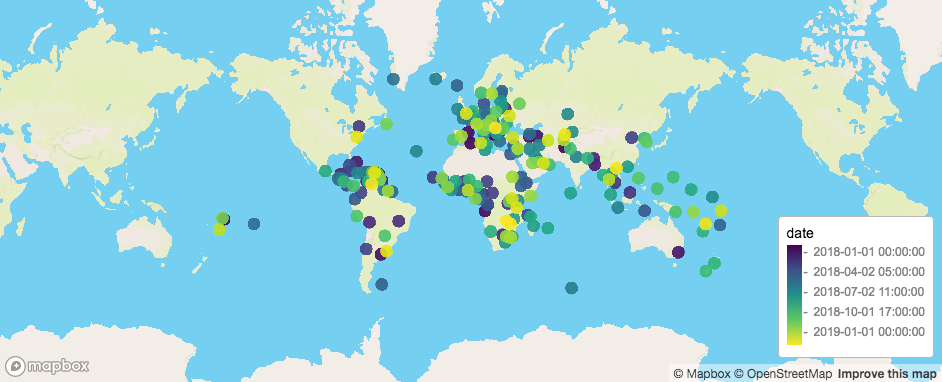
legend dates
Note, also, the final as.character() call in the formatting function. This is because the legend is converted to JSON using jsonify::to_json(), which uses the same C++ code as mapdeck (in fact, it IS the c++ code mapdeck uses). So if the legend contains a POSIXct object after formatting, it will again be converted to UTC.
Manual Legends
If you want to create your own legend you can do so using mapdeck_legend(), which accepts legend_elements as its argument, creates the required JSON, which you can then use in the legend argument of any of the layers
sf <- spatialwidget::widget_melbourne sf$my_colour <- ifelse( substr(sf$SA2_NAME, 1, 1) == "A", "#00FF00FF", "#FF0000FF") l1 <- legend_element( variables = c("Begins with A", "Doesn't begin with A") , colours = c("#00FF00FF", "#FF0000FF") , colour_type = "fill" , variable_type = "category" ) js <- mapdeck_legend(l1) mapdeck() %>% add_polygon( data = sf , fill_colour = "my_colour" , legend = js )
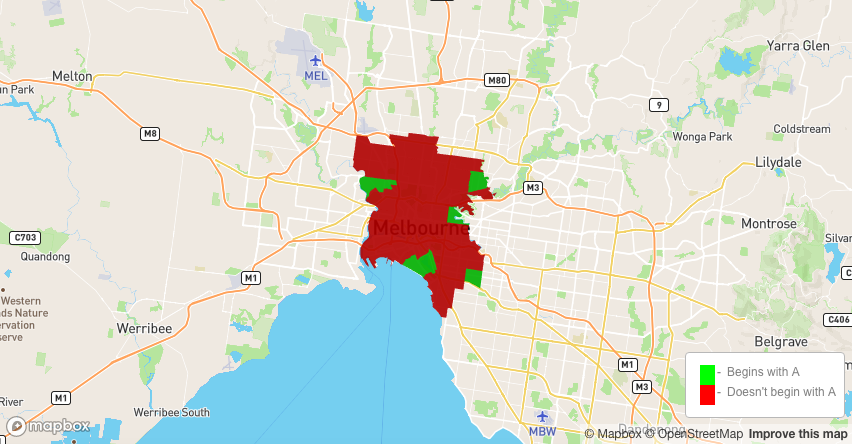
manual legend